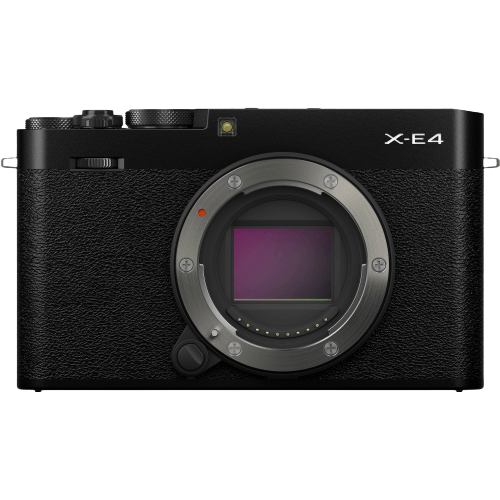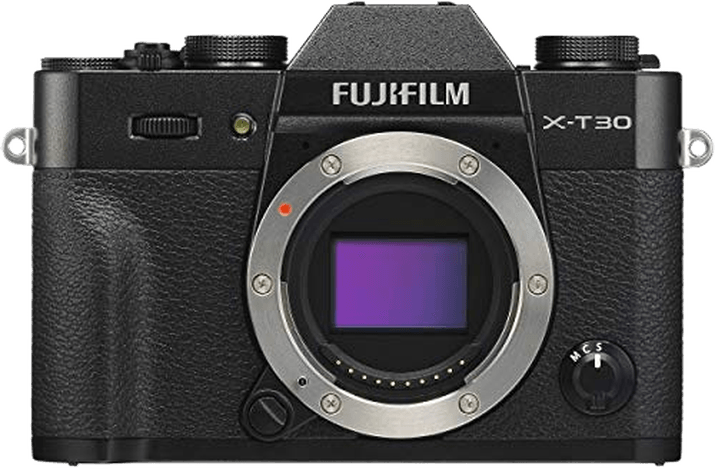Fujifilm X-E4 vs X-T30 Comparison
Fujifilm X-E4

Fujifilm X-T30

The Fujifilm X-E4 edges out the X-T30 by a slim margin, scoring 66/100 compared to the X-T30’s 65/100. Both mirrorless cameras share some common specifications, such as their release years in 2021 and 2019, and launch prices of $849 and $899, respectively.
The X-E4 excels with its smaller size and lighter weight, measuring 121 x 73 x 33mm and weighing 364g, making it more portable and convenient for on-the-go photography. On the other hand, the X-T30 has a slightly larger size of 118 x 83 x 47mm and a weight of 383g, which may appeal to those who prefer a more substantial feel in their hands.
Taking these factors into account, the Fujifilm X-E4 is the better choice for photographers seeking a compact and lightweight camera, while the X-T30 could be suitable for those who prioritize a more robust build.
Fujifilm X-E4 vs X-T30 Overview and Optics
When comparing the optics of the Fujifilm X-E4 and the Fujifilm X-T30, both cameras score 67/100, making it a tie in this category. These cameras share several specifications, including a 26-megapixel CMOS sensor, the X-Processor 4, an APS-C sensor size, the Fujifilm X lens mount, and no image stabilization.
The Fujifilm X-E4 has a shooting speed of 20 frames per second (fps), which is lower than the X-T30’s shooting speed of 30 fps. This means that the X-T30 is better for capturing fast-moving subjects and action shots. The higher shooting speed can be advantageous for sports and wildlife photography, providing more opportunities to capture the perfect shot.
On the other hand, the Fujifilm X-E4 does not have any significant advantages over the X-T30 in terms of optics. Both cameras have the same sensor and processor, which ensures equal image quality and performance. Additionally, neither camera has image stabilization, so they both rely on lenses with built-in stabilization or external stabilizers for steady shots.
Given the equal score and shared specifications, the choice between the Fujifilm X-E4 and X-T30 comes down to personal preference and specific needs. The X-T30’s higher shooting speed may be more appealing to photographers who frequently shoot fast-moving subjects, while the X-E4’s equal performance in other areas makes it a solid choice for those who prioritize other features. Ultimately, both cameras are capable of producing high-quality images with their shared optics.
Fujifilm X-E4 vs X-T30 Video Performance
The Fujifilm X-E4 and the Fujifilm X-T30 have the same video score of 91 out of 100. Both cameras offer 4K video resolution with maximum dimensions of 4096 x 2160 and have built-in time-lapse functionality. However, there are some differences in their video capabilities that set them apart.
The Fujifilm X-E4 outperforms the X-T30 in terms of video frame rate. With a maximum video frame rate of 240fps, the X-E4 allows for smoother slow-motion footage and better motion capture compared to the X-T30’s 120fps. This higher frame rate makes the X-E4 more suitable for videographers who require high-quality slow-motion shots.
On the other hand, the Fujifilm X-T30 does not offer any significant advantages over the X-E4 in terms of video capabilities. Both cameras share the same video resolution, dimensions, and time-lapse functionality, with the only difference being the X-T30’s lower maximum video frame rate.
In terms of video capabilities, the Fujifilm X-E4 is the better choice due to its higher maximum video frame rate. This advantage allows for improved slow-motion footage, setting it apart from the X-T30. While the X-T30 does not surpass the X-E4 in any notable aspect of video performance, it still offers excellent video quality with its 4K resolution and time-lapse functionality. For those who prioritize video capabilities, the Fujifilm X-E4 is the recommended option, while the X-T30 remains a solid choice for those who value both video and still photography features.
Fujifilm X-E4 vs X-T30 Features and Benefits
The Fujifilm X-E4 wins in the features comparison with a score of 72/100, while the Fujifilm X-T30 follows closely with a score of 70/100. Both cameras share several specifications, including a 3-inch screen size, touchscreen capabilities, flip screens, and the absence of GPS. They also both offer WIFI and Bluetooth connectivity.
The X-E4 outperforms the X-T30 in screen resolution, boasting 1,620,000 dots compared to the X-T30’s 1,040,000 dots. This higher resolution provides clearer and sharper image previews and menu navigation, enhancing the user experience.
The X-T30, despite its slightly lower score, still holds its own in the features department. It matches the X-E4 in most specifications, only falling short in screen resolution. This difference, while noteworthy, may not be a dealbreaker for some users who prioritize other aspects of a camera.
In comparing the Fujifilm X-E4 and X-T30, it is clear that both cameras are well-equipped with desirable features. The X-E4 takes the lead with a higher screen resolution, but the X-T30 remains a strong contender. Ultimately, the choice between these two cameras will depend on individual preferences and priorities, with the X-E4 being the better option for those who value a higher resolution display.
Fujifilm X-E4 vs X-T30 Storage and Battery
The Fujifilm X-E4 and Fujifilm X-T30 both score 35/100 for storage and battery, making them equal in this aspect. They share identical specifications in terms of storage capacity and battery life. Both cameras have a single memory card slot that accepts SD, SDHC, and SDXC cards (UHS-I compatible). Additionally, they both use the NP-W126S battery type, providing a battery life of 380 shots. USB charging is also available in both models.
Since both cameras have the same storage and battery specifications, there is no clear winner in this aspect. Neither camera outperforms the other in terms of storage capacity or battery life. However, this also means that both cameras offer reliable performance in these areas, making them suitable for various photography needs.
In the end, the choice between the Fujifilm X-E4 and Fujifilm X-T30 comes down to personal preferences and other factors, as their storage and battery capacities are evenly matched. Both cameras provide ample storage and battery life for most users, ensuring a satisfactory experience.
Fujifilm X-E4 vs X-T30 – Our Verdict
Are you still undecided about which camera is right for you? Have a look at these popular comparisons that feature the Fujifilm X-E4 or the Fujifilm X-T30:

